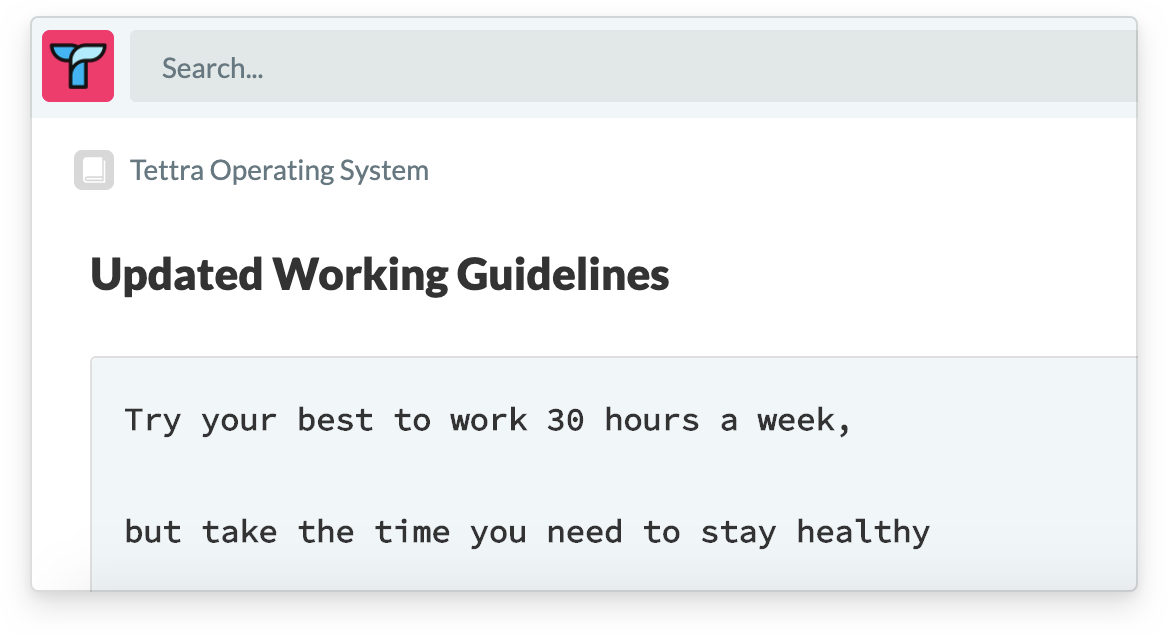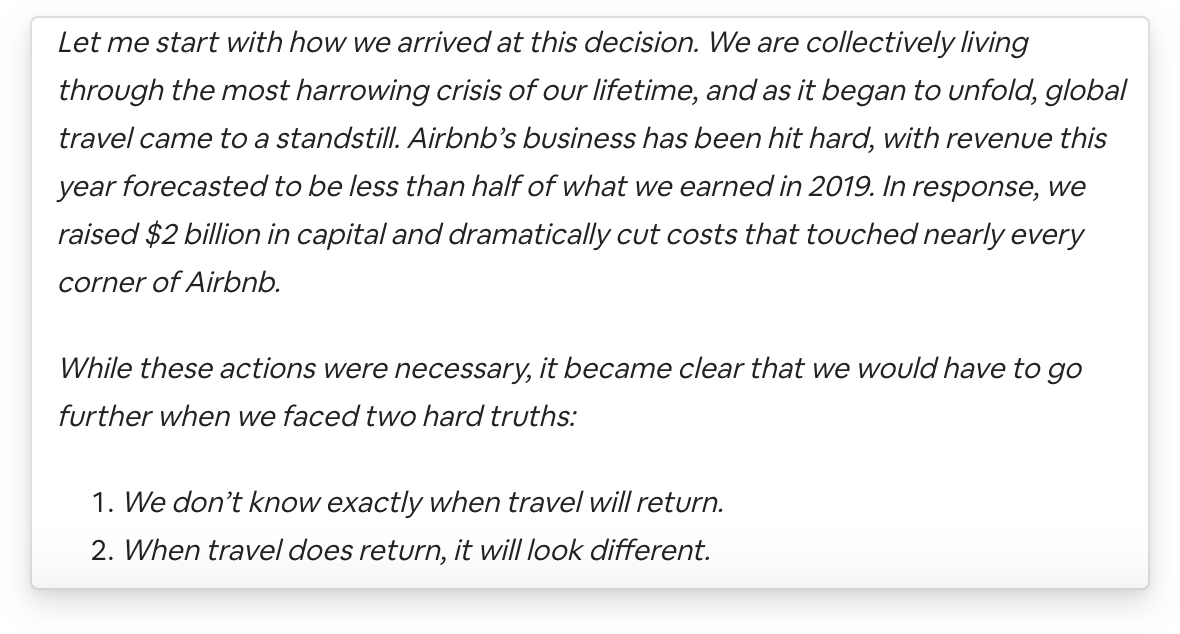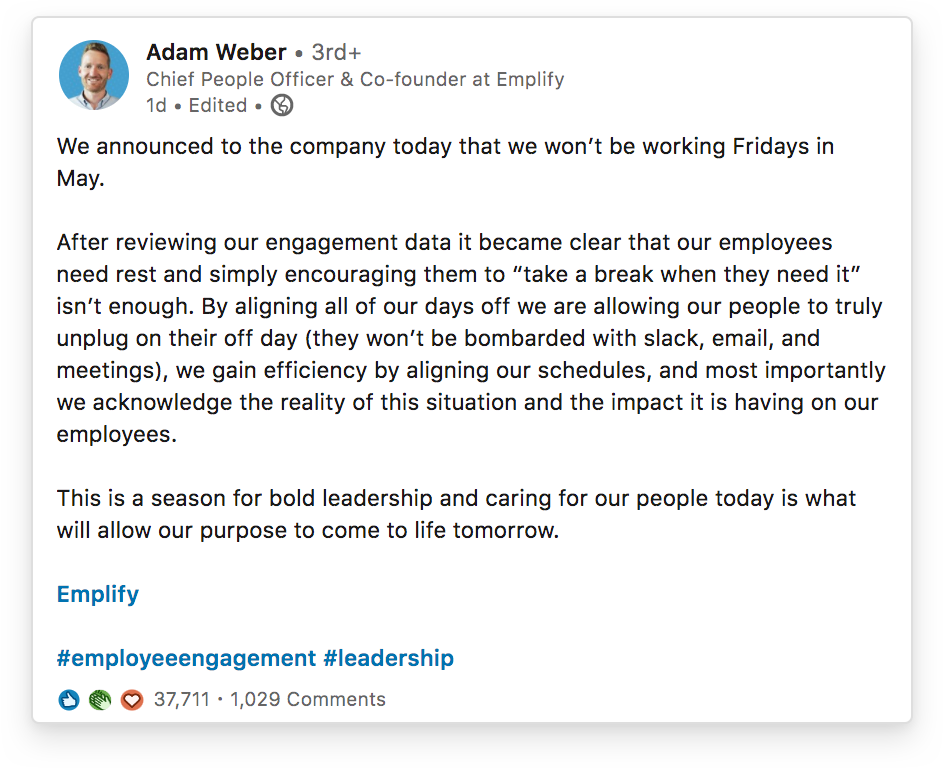- Introduction
- Acknowledge things aren't normal
- Be transparent about bad news
- Expect less
- Support family responsibilities
- Be flexible
- Encourage disconnecting
- Provide health resources
The global pandemic has led to historic economic disruption and upended what work looks like for anyone who’s lucky enough to be working from home right now.
Yet, many workplaces are expecting their teams to make this transition without missing a beat. Constant video meetings, all-day team chats, and, increasingly, employee surveillance, are becoming the norm as team leaders virtually try to exert the control they felt in the office.
But with other demands on people’s schedules, like constant childcare — not to mention the anxiety of an uncertain future — acting as if things are normal only creates more stress, burnout, and distrust. It also leads to low team morale.
An organization is more likely to endure, and even thrive, during a crisis if its leaders adapt expectations and focus on supporting the well-being of employees, not just the bottom line. Leading this way isn’t easy. No one has all the answers, and missteps are unavoidable. But there are a few forward-thinking organizations that are modeling what strong leadership looks like in uncertain times. Here are seven things they’re doing to support their teams through this crisis:
Acknowledge that things aren’t normal
With the complete disruption of normal life, workers report feeling less motivated and productive and more disconnected, all on top of the very real fear of losing their jobs.
In a time of crisis, clear and empathetic communication helps employees manage that anxiety, says Paul Argenti, a professor at the Tuck School of Business at Dartmouth College who studied executives’ actions after the September 11 attacks: “Before any other constructive action can take place — whether it’s serving customers or reassuring investors — the morale of employees must be rebuilt.”
This isn’t a time to put on a smile and pretend that everything is normal.
Unfortunately, a Gallup survey found only 45% of U.S. employees strongly agree that their organization cares about their overall well-being in light of the pandemic.
This isn’t a time to put on a smile and pretend that everything is normal. Leaders need to acknowledge the challenges people are dealing with and make space for them to talk about how they’re doing. This may seem scary, but it can be as simple as asking colleagues how they’re feeling, giving them space to name their emotions, and modeling the same vulnerability in return.

Crisis communication experts recommend communicating consistently and with appropriate frequency. Be focused and succinct — include the “‘need to know’ in your message, and skip the ‘nice to know’”, says Senka Hadzimuratovic, Head of Communications at Grammarly.
Test preparation company Magoosh’s Director of People Operations Amrita Kulkarni says: “We conduct regular work-from-home pulse surveys with our team to check in, and send out weekly Covid-19 newsletters from our VP of Operations, Peter, to provide reassurance to employees on how our business is doing as well as productivity tips and general wellbeing reminders.”
Wiki software company Tettra has created an Updated Working Guidelines page. Having a central communication spot during the pandemic means managers can easily point to a go-to source for company policy.

Though it’s hard to predict the future, organizations should do everything in their power to help their employees anticipate the months ahead. For example, Google and Facebook have extended remote work to the rest of 2020 and Twitter and Square are allowing it permanently. Clear communication goes a long way toward reducing anxiety and giving people the needed stability to focus on their work.
Be transparent, especially about bad news
It is particularly painful when the news you have to communicate is bad, like declines in revenue or layoffs that impact people’s livelihoods. But transparency right now is more essential than ever.
“Hiding bad news is virtually a reflex in most organizations, but thoughtful leaders recognize that speaking up early and truthfully is a vital strategy in a fast-moving crisis,” says Amy C. Edmondson, a professor at Harvard Business School.
Carta, a software company for managing startup equity, laid off 161 of its employees, a full 16% of the company. In an announcement on Medium, CEO Henry Ward gave his rationale for downsizing certain departments of the company and other cost-saving measures. He says that laid off employees will receive three months pay, health benefits, and assistance finding other jobs.
Though some disagree with how he came to the decision, Ward has been commended for his transparency about it.
Airbnb, which has been hit hard by the precipitous drop in travel, announced they were laying off 1,900 of their 7,500 employees, or 25% of the company. CEO Brian Chesky explained that the company’s revenue was forecast to be less than half of what it was in 2019, and acknowledged the extent of uncertainty in the travel industry: “1. We don’t know exactly when travel will return. 2. When travel does return, it will look different.” Like Carta, Airbnb mapped out what it would do for employees who were laid off, including covering salaries for several weeks and health insurance for one year.

You may have started 2020 with big goals, but in a recession simply maintaining current revenue is an accomplishment. It’s okay to acknowledge that your organization’s goals before the pandemic are no longer realistic and downshift what you expect, both in terms of growth and in employee productivity.
“I don’t think we can expect to hit the North Star metric projections we set for 2020,” founder and CEO Amir Salihefendić told the Doist team. “Our goal for this year isn’t growth or hitting milestones, but surviving this without huge scars.” Instead of sticking to their original product timeline, the company extended its next two project cycles from four weeks to six in order to relieve pressure on the team.

It’s understandable to dread the short term blowback from communicating bad news, but in the long run, you gain more respect and credibility, and you feel better, when you can be upfront about significant developments that impact your team.
Expect less — a lot less
With so much economic uncertainty, it’s tempting to compensate by pushing your team harder, but smart leaders are putting their people first right now.
Buffer, a social media management platform company, has assessed the frequency of meetings, changing or canceling those that don’t feel necessary. They’ve also started talking about goals rather than deadlines to lessen pressure on employees to deliver.
According to Mia Hamano, Product Manager at Buffer:
“We transparently addressed the fact that for our end of day team updates, that you may not have anything to share or may not have ‘completed’ a task — and that is perfectly acceptable. We wanted to address that, there will be more days where we may not make as much progress on something as we would pre-Covid, and that one shouldn’t have that unnecessary pressure to feel as though they need to ‘show what they accomplished’ each day.”
If business is slow, encourage team members to catch up on administrative tasks or work on professional development — things that are beneficial but don’t come with high expectations or hard deadlines attached.
Magoosh has let their employees do 50-80% of their normal time with full pay and “no questions,” says CEO and founder Bhavin Parikh. If someone needs to do under 50% they can work with HR to find a solution.
Remote software company RedGuava already had a 30-hour work week before the pandemic, “but [are] finding that’s not even enough for some, especially those with kids. Those doing home schooling are struggling to do even that. We work on a “do what you can” approach,” says CEO Joel Friedlander.
Communicate changed expectations to customers and clients as well. They are likely to be more understanding if they hear from you directly. Says John Kershaw, who runs software company M14:
“The first week lockdown started in the UK, I called each client and told them directly that my priority was their stability. I told our clients that in order for us to have the ability to make rapid decisions, we were removing all date estimates because they weren’t going to be good enough, and replacing them with more visibility on our progress. Clients feel more assured, get more information, and can make smarter decisions. Nobody is overworked, and planning is much easier.”
Julie Baumgardner, president and CEO of the non-profit First Things First, put it this way:
“Truth be told, probably all of us who lead are concerned about how we are going to pay bills and make payroll over time. No doubt, income and donations will be less and billable hours will decrease, but in the midst of this, we absolutely cannot forget the human factor. Pushing people harder will not make things better and they will certainly not forget how they were treated in the midst of this crisis.”
Or as Tettra’s CEO Andy Cook says: “We think it’s a smart long-term decision to acknowledge that times are not normal and to give our team permission to lay off the gas pedal to get through this as best they can.”
Affirm and model family responsibilities
While everyone is struggling to stay focused and get work done, parents with small children are experiencing the worst of it. The pandemic has upended childcare, and parents are dealing with the exhausting challenge of watching their kids and helping with remote education while doing their own jobs. BBC Dad has come to feel like all of us — as the Verge put it, “the OG of interrupted work from home calls.”
“If your child is in your Zoom meeting with you, you don’t need to apologize for that- that’s our normal and to be expected.”
“Many employees are now doing the work of three or more people. They’re doing their own jobs, their childcare worker’s jobs, and their children’s teacher’s jobs. Yet, many employers seem oblivious. I hear reports of companies cheerfully assuring their employees, and themselves, that everyone is working at, or close to, 100%,” says Joan C. Williams, director of the Center for WorkLife Law at the University of California’s Hastings College of the Law.
It’s stressful if team members feel they need to pretend they don’t have family obligations. Leaders can reaffirm to everyone, even those who aren’t caretaking, that there is life outside work and understand people are prioritizing their health and their loved ones.
Magoosh has tried to “normalize the balance of childcare with work,” by telling employees: “If your child is in your Zoom meeting with you, you don’t need to apologize for that — that’s normal and to be expected,” says Kulkarni.
Leaders can also help their employees by modeling. Doist CEO Amir Salihefendić communicated about his family to his team as global lockdowns were ramping up:
“Just a heads-up that my work situation is also being affected by the COVID-19 pandemic 👍 We are in a self-quarantine given the doubling of coronavirus cases in Chile in recent days… Our daycare center is also closed, so even without a self-quarantine, we would be in a bad position. With a toddler and a baby it’s hard to get deep work done 😅 I am also going to take Friday off to recharge my batteries. 👍”
Family cameos in Zoom calls bring home a reality that existed before the crisis: separating work and the rest of life isn’t straight-forward. The fact that parenting and other “personal” matters are now more visible may even lead to a fundamental shift in how people relate their work with the rest of their life. Forward-thinking organizations are already embracing that shift toward greater flexibility for families.
Allow flexible schedules with async communication
One of the best ways organizations can support employees with added family responsibilities or stress is by giving them more control over when they work.
Baumgardner has been flexible about when her team works, whether that means morning or night:
“I literally can’t expect that team members will be at their desk from 8-5 when they are trying to feed children meals and snacks (then help with cleanup), put younger kids down for naps, provide assistance or direction for schoolwork, break up the latest spat or make sure their kids are not occupying themselves with screens all day long. And laundry. Don’t forget the mountains of laundry. They’re also spending their energy trying to nurture other relationships in their lives and help family members/friends who have lost jobs, are ill or very susceptible to Covid-19 who may need their help in this challenging landscape. Not to mention, everyone is trying to keep surfaces wiped down to prevent the spread of sickness.”
But that level of flexibility is only possible if leaders resist the urge to monitor employee activity or require constant communication in video meetings and team chats.
As a fully remote company, Doist has long championed asynchronous communication. Instead of filling the workday with meetings or requiring teammates to stay connected to team messaging tools during all work hours, Doist uses practices and tools that give workers more control over when they communicate with their team. In an async environment, teammates aren’t expected to be immediately responsive. That means they can set their own schedules around their personal responsibilities in order to maximize their most productive hours.
“Tethering remote team members to your team communication tools undermines their ability to get things done,” says Salihefendić in an op-ed for Quartz. More control over the workday, on the other hand, leads to happier, more productive employees, better planning, and higher quality communication, not to mention more time for focused work and the ability to truly disconnect and recharge at the end of the day.
To create flexibility through async communication, he advises:
- Evaluate which team meetings can happen in writing instead.
- Empower teammates to decline meetings that aren’t relevant to them.
- Let your team know it’s okay to disconnect from email or chat tools like Slack.
- Set expectations for team response times in hours, not minutes.
- Be a model — don’t send emails or messages outside of your work hours.
- Use tools like Twist that make asynchronous communication easier.
- Ultimately, when people have more freedom to structure their day, they do better work — and you don’t have to spend as much energy monitoring them.
Help your team disconnect from work
The flipside of flexibility is that it can make it hard to set clear boundaries. Even before the pandemic, many workers felt the pressure to stay connected with work at all hours. With lines blurred even more working from home, some people are having an even harder time switching off. Parents and others who are feeling less than optimally productive may try to fit work wherever they can.
A lack of physical and temporal divides between work and personal life can quickly lead to burnout. According to one study, work hours in many nations have increased by 2 to 3 hours a day since the pandemic started. On top of that, people have been forced to cancel vacation plans due to travel restrictions.
Leaders should help their teams “create clear temporal boundaries” between professional and personal lives, advise Laura M. Giurge, at the University of Oxford and Vanessa K. Bohns at Cornell University.
Tell your team to disconnect on weekends and during non-work hours, and model this yourself. Don’t send emails during non-work hours, and create a culture where people know they aren’t expected to respond around the clock. Encourage people to take their vacation time, even if they don’t plan to go anywhere.
Some companies are experimenting with shorter work weeks — a small but emerging trend even before the pandemic.
Emplify, an employee analytics company, switched to a four-day work week for the month of May. They were concerned by data showing rest levels of their workers and hundreds of thousands of employees at other organizations were low, which can lead to disengagement and burnout.

In a post about the policy on LinkedIn that got over 1,500 responses, Chief People Officer and Cofounder Adam Weber, explains: “Folks in all businesses don’t feel like they have permission to take time off,” said Weber. “Our job as an engagement company is to lead by example.”
Joel Gascoigne, the CEO of Buffer, similarly announced a four-day work week for the month of May:
“This isn’t about us trying to get the same productivity in fewer days…We know many Buffer teammates will still have caregiving and other responsibilities on some or all of the working days, and flexibility is still supported and encouraged. This day off is to augment that flexibility and give everyone a coordinated break where they won’t feel like they’re behind or catching up when they return.”
Though it may seem like less gets done with more time off, working more doesn’t correlate with productivity — it actually leads to diminishing returns. In fact, the more we’re learning about work, the stronger the case is for working less, which is why even before the pandemic, more organizations were moving to a four-day work week.
Provide resources to support mental health
Nearly 70% of adults say coronavirus is the most stressful time of their entire career. The rate of severe distress for adults living at home with kids under the age of 18 rising from just 3% in 2018 to 37% last month.
Mental health has often been viewed as “too taboo for the workplace,” according to HR Executive. There’s no reason it needs to be.
Mental health has often been viewed as “too taboo for the workplace,” according to HR Executive. There’s no reason it needs to be. Acknowledging that it’s an issue and providing resources can go a long way. Organizations can communicate what’s available to employees to support their physical and mental health and well-being in a clear way. And don’t lean on a (possibly outdated or jargon-laden) HR manual — take the opportunity to update it with people-first policies or draft one from scratch.
Tettra provides detailed information about how to access mental health services, and the cost to employees, and Cook mentioned he used Psychology Today to find a therapist himself. He also points to resources like meditation apps — which the company lets employees expense — a mindfulness app Five Minute Journal, and StayFocused — to help block news and social media when needed.
Wellesley College has a comprehensive page with contacts for everything from employee assistance plans to resources for employees with children and the option to schedule a call with HR staff to get questions answered.
Starbucks has announced it will provide employees and eligible family members access to 20 therapy sessions, which they can seek confidentially.
Understand some employees may be reexamining their life and sense of meaning, which is common during times of significant change. You can work with team members to navigate this as it relates to work by helping them recraft their job. Have them answer some basic questions: “‘What is my job now? How do I go about helping my organization succeed? What do I want out of my career?’” The answers might not be the same as they were a month ago,” suggest Francesca Gino a professor at Harvard Business School and Dan Cable, a professor at London Business School.
Point employees to other resources to support their well-being, like childcare options. In the U.S. ChildCare Aware has information about every state, some of which are providing childcare free for essential workers.
Some governments have resource pages on employee health and well-being during Covid-19, like those in Canada, the United Kingdom, and the United States.
Before the pandemic, there were many ways in which the way we worked wasn’t working. When change is forced, it often leads to meaningful improvements in areas that were neglected during easier times. We’re all hoping that the current disruption will end as soon as possible. But in the meantime, there’s an opportunity for leaders to rebuild their workplace around transparency, trust, flexibility, empathy, and a real commitment to their employees’ health and well-being. The organizations who rise to the occasion will be the ones who come out stronger than before. Share with us in comments or @doist your experiences and advice about setting expectations in your organizations or teams during this time.

